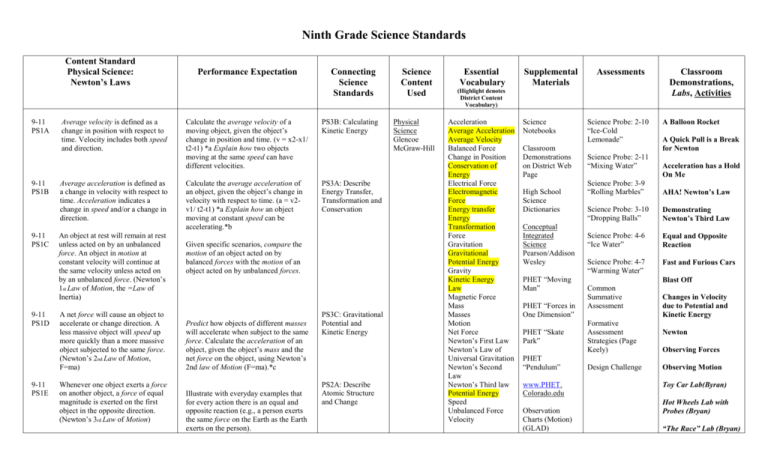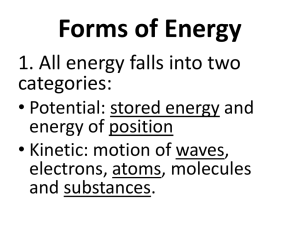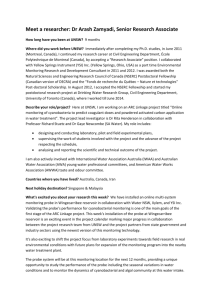
Ninth Grade Science Standards
Content Standard
Physical Science:
Newton’s Laws
9-11
PS1A
9-11
PS1B
9-11
PS1C
9-11
PS1D
9-11
PS1E
Average velocity is defined as a
change in position with respect to
time. Velocity includes both speed
and direction.
Average acceleration is defined as
a change in velocity with respect to
time. Acceleration indicates a
change in speed and/or a change in
direction.
An object at rest will remain at rest
unless acted on by an unbalanced
force. An object in motion at
constant velocity will continue at
the same velocity unless acted on
by an unbalanced force. (Newton’s
1st Law of Motion, the =Law of
Inertia)
A net force will cause an object to
accelerate or change direction. A
less massive object will speed up
more quickly than a more massive
object subjected to the same force.
(Newton’s 2nd Law of Motion,
F=ma)
Whenever one object exerts a force
on another object, a force of equal
magnitude is exerted on the first
object in the opposite direction.
(Newton’s 3rd Law of Motion)
Performance Expectation
Connecting
Science
Standards
Calculate the average velocity of a
moving object, given the object’s
change in position and time. (v = x2-x1/
t2-t1) *a Explain how two objects
moving at the same speed can have
different velocities.
PS3B: Calculating
Kinetic Energy
Calculate the average acceleration of
an object, given the object’s change in
velocity with respect to time. (a = v2v1/ t2-t1) *a Explain how an object
moving at constant speed can be
accelerating.*b
PS3A: Describe
Energy Transfer,
Transformation and
Conservation
Given specific scenarios, compare the
motion of an object acted on by
balanced forces with the motion of an
object acted on by unbalanced forces.
Predict how objects of different masses
will accelerate when subject to the same
force. Calculate the acceleration of an
object, given the object’s mass and the
net force on the object, using Newton’s
2nd law of Motion (F=ma).*c
Illustrate with everyday examples that
for every action there is an equal and
opposite reaction (e.g., a person exerts
the same force on the Earth as the Earth
exerts on the person).
PS3C: Gravitational
Potential and
Kinetic Energy
PS2A: Describe
Atomic Structure
and Change
Science
Content
Used
Physical
Science
Glencoe
McGraw-Hill
Essential
Vocabulary
Supplemental
Materials
Assessments
(Highlight denotes
District Content
Vocabulary)
Acceleration
Average Acceleration
Average Velocity
Balanced Force
Change in Position
Conservation of
Energy
Electrical Force
Electromagnetic
Force
Energy transfer
Energy
Transformation
Force
Gravitation
Gravitational
Potential Energy
Gravity
Kinetic Energy
Law
Magnetic Force
Mass
Masses
Motion
Net Force
Newton’s First Law
Newton’s Law of
Universal Gravitation
Newton’s Second
Law
Newton’s Third law
Potential Energy
Speed
Unbalanced Force
Velocity
Science
Notebooks
Classroom
Demonstrations
on District Web
Page
High School
Science
Dictionaries
Conceptual
Integrated
Science
Pearson/Addison
Wesley
PHET “Moving
Man”
PHET “Forces in
One Dimension”
PHET “Skate
Park”
PHET
“Pendulum”
www.PHET.
Colorado.edu
Observation
Charts (Motion)
(GLAD)
Science Probe: 2-10
“Ice-Cold
Lemonade”
Science Probe: 2-11
“Mixing Water”
Classroom
Demonstrations,
Labs, Activities
A Balloon Rocket
A Quick Pull is a Break
for Newton
Acceleration has a Hold
On Me
Science Probe: 3-9
“Rolling Marbles”
AHA! Newton’s Law
Science Probe: 3-10
“Dropping Balls”
Demonstrating
Newton’s Third Law
Science Probe: 4-6
“Ice Water”
Equal and Opposite
Reaction
Science Probe: 4-7
“Warming Water”
Fast and Furious Cars
Blast Off
Common
Summative
Assessment
Formative
Assessment
Strategies (Page
Keely)
Design Challenge
Changes in Velocity
due to Potential and
Kinetic Energy
Newton
Observing Forces
Observing Motion
Toy Car Lab(Byran)
Hot Wheels Lab with
Probes (Bryan)
“The Race” Lab (Bryan)
9-11
PS1F
9-11
PS1G
9-11
PS1H
Gravitation is a universal attractive
force by which objects with mass
attract one another. The
gravitational force between two
objects is proportional to their
masses and inversely proportional
to the square of the distance
between the objects. (Newton’s Law
of Universal Gravitation)
Electrical force is a force of nature,
independent of gravity that exists
between charged objects. Opposite
charges attract while like charges
repel.
Electricity and magnetism are two
aspects of a single electromagnetic
force. Moving electric charges
produce magnetic forces, and
moving magnets produce electric
forces.
Pendulum Lab (Bryan)
Predict how the gravitational force
between two bodies would differ for
bodies of different masses or different
distances apart.*d Explain how the
weight of an object can change while its
mass remains constant.
Car Input Chart
(GLAD)
Galileo Lab (John)
Velocity
Acceleration
Narrative
(GLAD)
Friction lab (Judy)
Electricity Lab (Linda)
Electromagnet Lab
(Lorena)
“The Dam
Transfer” Input
Chart (GLAD)
Predict whether two charged objects
will attract or repel each other, and
explain why.
Skateboard Lab (Forces
and Acceleration)
(Lorena)
Gravitational
Potential Kinetic
Energy Input
Chart (GLAD)
Demonstrate and explain that an electric
current flowing in a wire will create a
magnetic field around the wire (i.e.,
electromagnetic effect). Demonstrate
and explain that moving a magnet near
a wire will cause an electric current to
flow in the wire (i.e., the generator
effect).
Mousetrap Lab (kirby)
“Garbage Bag Physics”
Judy
Medieval
Trebuchets Web
Site
“Toy Cars Activity”
Judy
Roller Coaster
Design
“Build Electric Motor
Activity” Judy
Accident
Investigation
“Stactic Electricity
Activity” Linda
Friction
Coefficient
Physical Science:
Chemical Reactions
9-11
PS2A
Atoms are composed of protons,
neutrons, and electrons. The
nucleus of an atom takes up very
little of the atom’s volume but
makes up almost all of the mass.
Performance Expectation
Describe the relative charges, masses,
and locations of the protons, neutrons,
and electrons in an atom of an element.
Connecting
Science
Standards
Science
Content
Used
Physical
Science
Glencoe
McGraw-Hill
Essential
Vocabulary
Supplemental
Materials
“Inertia Activity”
Judy
Assessments
(Highlight denotes
District Content
Vocabulary)
Atomic mass number
Atomic number
Atoms
Chemical properties
Chemical reactions
Science
Notebooks
Science Probe: 1-10
“Is It Matter?”
Classroom
Demonstrations
Science Probe: 2-1
“Comparing Cubes”
Classroom
Demonstrations,
Labs, Activities
Atomic Attraction
Pushy Molecules
Fission and Fusion
The nucleus contains protons and
neutrons, which are much more
massive than the electrons
surrounding the nucleus. Protons
have a positive charge, electrons
are negative in charge, and neutrons
have no net charge.
9-11
PS2B
9-11
PS2C
9-11
PS2D
9-11
PS2E
****
Atoms of the same element have the
same number of protons. The
number and arrangement of
electrons determines how the atom
interacts with other atoms to form
molecules and ionic compounds.
When elements are listed in order
according to the number of protons,
repeating patterns of physical and
chemical properties identify
families of elements with similar
properties. This Periodic Table is a
consequence of the repeating
pattern of outermost electrons.
Covalent Bond
Electrons
Elements
Families
Fission
Fusion
Ion
Ionic Bond
Ionic compounds
Matter
Molecules
Negative charge
Neutrons
Nuclear energy
Nuclear reaction
Nucleus
Patterns
Periodic Table
Physical properties
Positive charge
Protons
Relationships
Given the number and arrangement of
electrons in the outermost shell of an
atom, predict the chemical properties of
the element.
Given the number of protons, identify
the element using a Periodic Table.
Explain the arrangement of the elements
on the Periodic Table, including the
significant relationships among
elements in a given column or row.
on District Web
Page
High School
Science
Dictionaries
Conceptual
Integrated
Science
Pearson/Addison
Wesley
www.privatehand.
com/flash/
elements7.swf
Elements of the
Periodic Table
(using actual
elements)
Glow Sticks
(inquiry lab)
Ions are produced when atoms or
molecules lose or gain electrons,
thereby gaining a positive or
negative electrical charge. Ions of
opposite charge are attracted to
each other, forming ionic bonds.
Chemical formulas for ionic
compounds represent the proportion
of ion of each element in the ionic
array.
Explain how ions and ionic bonds are
formed (e.g., sodium atoms lose an
electron and chlorine atoms gain an
electron, then the charged ions are
attracted to each other and form bonds).
Explain the meaning of a chemical
formula for an ionic array (e.g., NaCl).
Compounds are composed of two or
more elements bonded together in a
fixed proportion by sharing
electrons between atoms, forming
Covalent bonds. Such compounds
consist of well-defined molecules.
Formulas of covalent compounds
represent the types and number of
atoms of each element in each
molecule.
Give examples to illustrate that
molecules are groups of two or more
atoms bonded together (e.g., a molecule
of water is formed when one oxygen
atom shares electrons with two
hydrogen atoms). Explain the meaning
of a chemical formula for a molecule
(e.g., CH4 or H2O).*a
PS2G: Chemical
Reactions
PS3A: Energy
Transfer and
Transformation
Science Probe: 3-1
“Pennies”
Burning Magnesium
Strip
Science Probe: 4-2
“Iron Bar”
Zinc Hydrochloric
Acid
Science Probe: 4-5
“Salt Crystals”
Sugar Sulfuric
Acid
Common Summative
Assessment
“The Flame Test”
(Linda)
Formative
Assessment
Strategies (Page
Keely)
“Metal and Nonmetal”
(Linda)
“Baggie Chemistry Lab”
(Judy)
“Reaction Time Lab”
(Kirby)
Making Ionic
Compound Activity
GAK Polymers
History of the
Atom (reading)
Partner Bonding
Activity
9-11
PS2G
****
9-11
PS2H
****
9-11
PS2I
****
9-11
PS2J
****
Chemical reactions change the
arrangement of atoms in the
molecules of substances. Chemical
reactions release or acquire energy
from their surroundings and result
in the formation of new substances.
Solutions are mixtures in which
particles of one substance are
evenly distributed through another
substance. Liquids are limited in the
amount of dissolved solid or gas
that they can contain. Aqueous
solutions can be described by
relative quantities of the dissolved
substances and acidity or alkalinity
(pH).
The rate of a physical or chemical
change may be affected by factors
such as temperature, surface area,
and pressure.
The number of neutrons in the
nucleus of an atom determines the
isotope of the element. Radioactive
isotopes are unstable and emit
particles and/or radiation. Though
the timing of a single nuclear decay
is unpredictable, a large group of
nuclei decay at a predictable rate,
making it possible to estimate the
age of materials that contain
radioactive isotopes.
Describe at least three chemical
reactions of particular importance to
humans (e.g., burning of fossil fuels,
photosynthesis, rusting of metals). Use a
chemical equation to illustrate how the
atoms in molecules are arranged before
and after a reaction. Give examples of
chemical reactions that either release or
acquire energy and result in the
formation of new substances.
Give examples of common solutions.
Explain the differences among the
processes of dissolving, melting, and
reacting. Predict the result of adding
increased amounts of a substance to an
aqueous solution, in concentration and
pH.*b
Predict the Effect of a change in
temperature, surface area, pressure, on
the rate of a given physical or chemical
change.*b
Given the atomic number and atomic
mass number of an isotope, students
draw and label a model of the isotope’s
atomic structure (number of protons,
neutrons and electrons). Given data
from a sample, use a decay curve for a
radioactive isotope to find the age of the
sample. Explain how the decay curve is
derived. *c
9-11
PS2K
Nuclear reactions convert matter
into energy, releasing large
amounts of energy compared with
chemical reactions. Fission is the
splitting of a large nucleus into
smaller pieces. Fusion is the joining
of nuclei and is the process that
generates energy in the Sun and
other stars.
Physical Science:
Transformation and
Conservation of Energy
9-11
PS3A
9-11
PS3B
9-11
PS3C
9-11
PS3D
Although energy can be transferred
from one object to another and can
be transformed from one form of
energy to another form, the total
energy in a closed system is
constant and can neither be created
nor destroyed. (Conservation of
Energy)
Kinetic energy is the energy of
motion. The kinetic energy of an
object is defined by the equation:
Ek = ½ mv2
Gravitational potential energy is
due to the separation of mutually
attracting masses. Transformations
can occur between gravitational
potential energy and kinetic energy,
but the total amount of energy
remains constant.
Waves (including sound, seismic,
light, and water waves) transfer
energy when they interact with
matter. Waves can have different
wavelengths, frequencies,
amplitudes, and travel at different
Distinguish between nuclear fusion and
nuclear fission by describing how each
process transforms elements present
before the reaction into elements present
after the reaction.
Performance Expectation
Connecting
Science
Standards
Describe a situation in which energy is
transferred from one place to another,
and explain how energy is conserved.*a
Describe a situation in which energy is
transformed from one form to another
and explain how energy is conserved.*a
Physical
Science
Glencoe
McGraw-Hill
Calculate the kinetic energy of an
object, given the object’s mass and
velocity. *b
Give an example in which gravitational
potential energy and kinetic energy are
changed from one to the other (e.g., a
child on a swing illustrates the
alternating transformation of kinetic
and gravitational potential energy).
Demonstrate how energy can be
transmitted by sending waves along a
spring or rope. Characterize physical
waves by frequency, wavelength,
amplitude, and speed. Apply these
properties to the pitch and volume of
sound waves, and to the wavelength and
Science
Content
Used
PS1H:
Electromagnetic
Force
Essential
Vocabulary
Supplemental
Materials
Assessments
(Highlight denotes
District Content
Vocabulary)
Amplitudes
Electromagnetic
spectrum
Electromagnetic
waves
Energy Transfer
Equilibrium
Frequencies
Infrared
Light Waves
Medium
Pitch
Radio
Seismic Waves
Sound Waves
Ultraviolet
Visible Light
Volume
Water Waves
Wave amplitude
Wave frequency
Wavelength
Waves
X-rays
Science
Notebooks
Classroom
Demonstrations
on District Web
Page
High School
Science
Dictionaries
Conceptual
Integrated
Science
Pearson/Addison
Wesley
Wave
Observation Chart
(GLAD)
Reading Text
Questions on
Waves from CIS
Science Probe: 1-1
“Can It Reflect
Light?”
Classroom
Demonstrations,
Labs, Activities
P & S Waves in the
Hallway
“Slinky Lab”
Science Probe: 1-2
“Apple in the Dark”
Science Probe: 1-3
“Birthday Candles”
Science Probe: 1-4
“Making Sound”
Common Summative
Assessment
Formative
Assessment
Strategies (Page
Keely)
“Radar Lab”
Tuning Fork Activity
speeds.
9-11
PS3E
Electromagnetic waves differ from
physical waves because they do not
require a medium and they all travel
at the same speed in a vacuum. This
is the maximum speed that any
object or wave can travel. Forms of
Electromagnetic waves include Xrays, ultraviolet, visible light,
infrared, and radio.
Earth and Space Science:
Evolution of the Universe
9-11
ES1A
9-11
ES1B
magnitude of water waves.*b
Illustrate the electromagnetic spectrum
with a labeled diagram, showing how
regions of the spectrum differ regarding
wavelength, frequency, and energy, and
how they are used (e.g., infrared in heat
lamps, microwaves for heating foods,
X-rays for medical imaging).
Performance Expectation
Stars have ―life cycles.‖ During
their active periods, stars produce
heavier elements, starting with the
fusion of hydrogen to form helium.
The heaviest elements are formed
when massive stars ―die‖ in
massive explosions.
Connect the life cycles of stars to the
production of elements through the
process of nuclear fusion.
The Big Bang theory of the origin
of the universe is based on evidence
(e.g., red shift) that all galaxies are
rushing apart from one another. As
space expanded, and matter began
to cool, gravitational attraction
pulled clumps of matter together,
forming the stars and galaxies,
clouds of gas and dust, and
planetary systems that we see
today. If we were to run time
backwards we would find that all of
the galaxies were in the same place
14.7 billion years ago.
Cite evidence that supports the ―Big
Bang theory‖ (e.g., red shift of
galaxies).
Connecting
Science
Standards
Science
Content
Used
Earth Science
Glencoe
McGraw-Hill
PS1F: Gravitational
Force
Essential
Vocabulary
Supplemental
Materials
Assessments
(Highlight denotes
District Content
Vocabulary)
Big Bang theory
Dwarf planet
Elements
Fusion
Galaxy
Gravitational
attraction
Life cycles
Planetary system
Red Shift
Space Dust clouds
Space Gas clouds
Stars
Universe
Science
Notebooks
Classroom
Demonstrations
on District Web
Page
High School
Science
Dictionaries
Conceptual
Integrated
Science
Pearson/Addison
Wesley
Astronomy Night
“Astronomy” Big
Book (GLAD)
Science Probe: 2-24
“Emmy’s Moon and
Stars”
Science Probe: 2-25
“Objects in the Sky”
Science Probe: 3-25
“Where Do Stars
Go?”
Common Summative
Assessment
Formative
Assessment
Strategies (Page
Keely)
Classroom
Demonstrations,
Labs, Activities
HR Diagram Activity
Big Bang Balloon Lab
(Lorena)
Earth and Space Science:
Energy in Earth Systems
9-11
ES2A
9-11
ES2B
Global climate differences result
from the uneven heating of Earth’s
surface by the Sun. Seasonal
climate variations are due to the tilt
of Earth’s axis with respect to the
plane of Earth’s nearly circular
orbit around the Sun.
Climate is determined by energy
transfer from the sun at and near
Earth's surface. This energy
transfer is influenced by dynamic
processes such as cloud cover and
Earth's rotation, as well as static
conditions such as proximity to
mountain ranges and the ocean.
Human activities, such as burning
of fossil fuels, also affect the Global
climate.
Performance Expectation
Connecting
Science
Standards
Explain that Earth is warmer near the
equator and cooler near the poles due to
the uneven heating of Earth by the Sun.
Explain that it’s warmer in summer and
colder in winter for people in
Washington State because the intensity
of sunlight is greater and the days are
longer in summer than in winter.
Connect these seasonal changes in
sunlight to the tilt of Earth’s axis with
respect to the plane of its orbit around
the Sun.
Explain how the climate in the
Northwest region is affected by
seasonal weather patterns, as well as
other factors such as the addition of
greenhouse gases to the atmosphere,
and proximity to mountain ranges and
to the ocean.
Science
Content
Used
Earth Science
Glencoe
McGraw-Hill
PS3A: Energy
Transfers
Essential
Vocabulary
Supplemental
Materials
Assessments
(Highlight denotes
District Content
Vocabulary)
Axis
Climate
Condensation
Energy Transfer
Fossil fuels
Global Climate
Global climate
Greenhouse gases
Orbit
Seasonal
Seasonal weather
patterns
Science
Notebooks
Science Probe: 2-22
“Mountaintop Fossil”
Classroom
Demonstrations
on District Web
Page
Science Probe: 3-23
“Summer Talk”
High School
Science
Dictionaries
Conceptual
Integrated
Science
Pearson/Addison
Wesley
Reasons for the
Seasons Input
Chart
Washington State
Rain-shadow
Effect
Science Probe: 4-19
“Camping Trip”
Science Probe: 4-20
“Global Warming”
Science Probe: 4-21
“Where Does Oil
Come From?”
Science Probe: 4-22
“Where Would It
Fall?”
Common Summative
Assessment
Formative
Assessment
Strategies (Page
Keely)
Classroom
Demonstrations,
Labs, Activities
“Reasons for the
Seasons” Lab
“Climate in a Bottle”
(Judy, Shelly, John)
“Making Rain in a
Bottle” (Judy)
Earth and Space Science:
Evolution of Earth
9-11
ES3A
9-11
ES3B
9-11
ES3D
Interactions among the solid Earth,
the oceans, the atmosphere, and
organisms have resulted in the
ongoing evolution of the Earth
system. We can observe changes
such as earthquakes and volcanic
eruptions on a human time scale,
but many processes such as
mountain building and plate
movements take place over
hundreds of millions of years.
Geologic time can be estimated by
several methods (e.g., counting tree
rings, observing rock sequences,
using fossils to correlate sequences
at various locations, and using the
known decay rates of radioactive
isotopes present in rocks to measure
the time since the rock was
formed).
Data gathered from a variety of
methods have shown that Earth has
gone through a number of periods
when Earth was much warmer and
much colder than today.
Performance Expectation
Interpret current rock formations of the
Pacific Northwest as evidence of past
geologic events. Consider which Earth
processes may have caused these
landforms (e.g., erosion, deposition, and
scraping of terrain by glaciers, floods,
volcanic eruptions, tsunami), and
construct a timeline showing the
development of the landform.
Explain how decay rates of radioactive
materials in rock layers are used to
establish the timing of geologic events.
*a Given a geologic event, explain
multiple methods that could be used to
establish the timing of that event.
Describe factors that change climates
over long periods of time and cite
methods that scientists have found to
gather information on ancient climates.
Connecting
Science
Standards
Science
Content
Used
PS3C: Gravitational
Energy
Earth Science
Glencoe
McGraw-Hill
PS2J: Radioactivity
PS2I: Rate of
Physical/Chemical
Change
PS2H: Solutions/pH
PS2G: Chemical
Reactions (Fossil
Fuels)
Essential
Vocabulary
Supplemental
Materials
Assessments
(Highlight denotes
District Content
Vocabulary)
Biogeochemical
cycle
Decay rate
Deposition
Earth system
Erosion
Evolution
Floods
Fossil fuels
Geologic time
Glaciers
Index Fossils
Interactions
Isotopes
Landform
Nitrogen cycle
Organisms
Radioactive
Scraping
Terrain
Tsunami
Volcanic eruptions
Classroom
Demonstrations,
Labs, Activities
Science
Notebooks
Science Probe: 1-22
‘Beach Sand”
“Paleontology Lab”
(Jack, Bryan)
Classroom
Demonstrations
on District Web
Page
Science Probe: 2-20
“What is a Rock?” #1
“Snickers Lab”
(Lorena)
Science Probe: 2-21
“What is a Rock?” #2
“Penny Isotopes Lab”
(Judy)
Science Probe: 2-22
“Mountaintop Fossil”
“M & M Decay Lab”
(Judy)
Common Summative
Assessment
“pH Lab”
(Linda)
High School
Science
Dictionaries
Conceptual
Integrated
Science
Pearson/Addison
Wesley
Relative dating
Worksheet
Mega Flows Input
Chart
Mega Floods
Video
Formative
Assessment
Strategies (Page
Keely)








